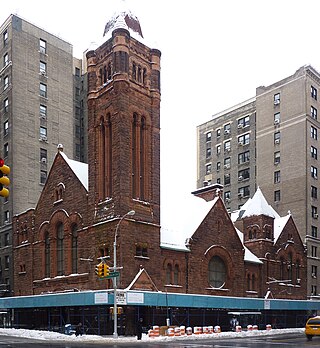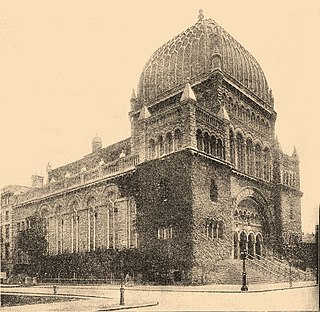
Congregation Emanu-El of New York is the first Reform Jewish congregation in New York City. It has served as a flagship congregation in the Reform branch of Judaism since its founding in 1845. The congregation uses Temple Emanu-El of New York, one of the largest synagogues in the world.

Moorish Revival or Neo-Moorish is one of the exotic revival architectural styles that were adopted by architects of Europe and the Americas in the wake of Romanticist Orientalism. It reached the height of its popularity after the mid-19th century, part of a widening vocabulary of articulated decorative ornament drawn from historical sources beyond familiar classical and Gothic modes. Neo-Moorish architecture drew on elements from classic Moorish architecture and, as a result, from the wider Islamic architecture.

Leopold Eidlitz was an American architect best known for his work on the New York State Capitol, as well as "Iranistan" (1848), P. T. Barnum's house in Bridgeport, Connecticut; St. Peter's Church, on Westchester Avenue at St. Peter's Avenue in the Bronx (1853); the Brooklyn Academy of Music on Montague Street in Brooklyn ; the former Temple Emanu-El ; the Broadway Tabernacle ; the completion of the Tweed Courthouse (1876–81); and the Park Presbyterian Chapel on West 86th Street and Amsterdam Avenue.

Central Synagogue is a Reform Jewish congregation and synagogue at 652 Lexington Avenue, at the corner of 55th Street in the Midtown Manhattan neighborhood of New York City. The current congregation was formed in 1898 through the merger of two 19th-century synagogues: Shaar Hashomayim and Ahawath Chesed. The synagogue building was constructed from 1870 to 1872 for Ahawath Chesed. As of 2014, Angela Buchdahl is Central's senior rabbi.

Meserich Synagogue, Meserich Shul or Meseritz Shul, also known as Edes Israel Anshei Mesrich, Edath Lei'Isroel Ansche Meseritz or Adas Yisroel Anshe Mezeritz, is an Orthodox Jewish synagogue located at 415 East 6th Street, in the East Village of Manhattan, New York City, New York, United States.

Ohaveth Sholum Congregation was the first synagogue in Seattle, Washington, in the United States.
Kol Ami is a Reform Jewish congregation and synagogue located at 225 North Country Club Road, in Tucson, Arizona, in the United States. The congregation was formed through the 2019 merger of Temple Emanu-El and the Congregation Or Chadash, that was established in 1995. The leaders of Temple Emanuel-El and Congregation Or Chadash began discussions about a potential merger in 2018. The merger of the two Reform congregations was consummated the following year, as Kol Ami.
Marc Eidlitz was a builder active in New York City, where he was prominent in the construction industry, in partnership with his son Otto Eidlitz (1860–1928).

Temple Emanu-El-Beth Sholom, Westmount is a Reform synagogue in Westmount, Quebec. The syngagoue is the oldest Liberal or Reform synagogue in Canada, incorporated on March 30, 1883, and is the only Reform congregation in Quebec.
Synagogues may be considered "oldest" based on different criteria, and can be oldest in the sense of oldest surviving building, or oldest in the sense of oldest congregation. Some old synagogue buildings have been in continuous use as synagogues, while others have been converted to other purposes, and others, such as the Touro Synagogue, were shuttered for many decades. Some early established congregations have been in continuous existence, while other early congregations have ceased to exist.

St. Ann’s Church was the name of a former Roman Catholic parish church at 110-120 East 12th Street between Fourth and Third Avenues in the East Village neighborhood of Manhattan, New York City.

West-Park Presbyterian Church is a Romanesque Revival Presbyterian church located on the corner of Amsterdam Avenue at 86th Street on the Upper West Side of Manhattan in New York City. It consists of a main sanctuary and chapel.

Temple Israel of the City of New York is a Reform Jewish congregation and synagogue located at 112 East 75th Street, on the Upper East Side of Manhattan in New York City, New York, United States. The congregation was incorporated by German Jews in 1873.

Henry Fernbach (1829—1883) was an architect in New York City. Born in Breslau, which then belonged to Germany, he immigrated to the U.S. in 1848 or in 1855.
Benjamin Winter Sr. was a real estate developer in New York City and founder of Winter Incorporated. Winter served as president of the American Federation of Polish Jews.

Temple Beth-El was a Reform Jewish congregation and synagogue located at 945 Fifth Avenue and 76th Street in the Upper East Side of Manhattan in New York City, New York, in the United States. The synagogue operated between 1891 until c. 1929, and was demolished in 1947. The Temple Beth-El congregation merged with Congregation Emanu-El of New York in 1927.

Temple Emanu-El of New York is a synagogue at 1 East 65th Street on the Upper East Side of Manhattan, at the northeast corner with Fifth Avenue, in New York City, New York, United States. It was built in 1928–1930 for the Reform Jewish Congregation Emanu-El of New York. With capacity for 2,500 seated worshippers, it is one of the largest synagogues in the world.

















